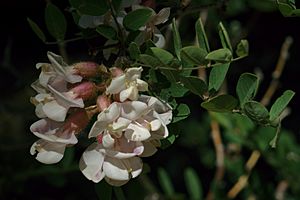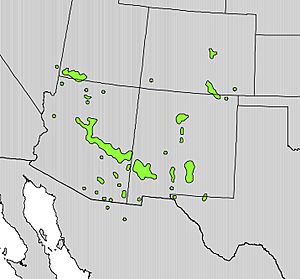New Mexican locust facts for kids
Quick facts for kids New Mexican locust |
|
|---|---|
 |
|
| Conservation status | |
| Scientific classification | |
| Genus: |
Robinia
|
| Species: |
neomexicana
|
 |
|
| Natural range | |
The New Mexican locust (scientific name: Robinia neomexicana) is a cool shrub or small tree. People also call it the Southwest, desert, pink, or rose locust. It belongs to the pea family, called Fabaceae, and a smaller group within that family known as Faboideae.
Where Does the New Mexican Locust Grow?
This plant naturally grows in the Southwestern United States. You can find it in places like southeastern California, southwestern Utah, Arizona, and New Mexico. It also grows in far west Texas and parts of northern Mexico. From central New Mexico, it stretches north into Colorado, especially near the eastern Rocky Mountains.
In Arizona, it grows across the Arizona transition zone, the Mogollon Rim, and the White Mountains. It also appears in western and southwestern New Mexico. In California, it's not very common. You might find it in canyons in the Mojave Desert below 1500 meters (about 5000 feet).
Further east, it usually grows between 1200 and 2600 meters (about 4000 to 8500 feet). It likes to be near streams, at the bottom of valleys, or on the sides of canyons.
What Does the New Mexican Locust Look Like?
The New Mexican locust usually grows to be 5 to 10 meters tall (about 16 to 33 feet). Sometimes, it can even reach 15 meters (about 49 feet)! Its young branches have tiny, stiff bristles.
The leaves are 10 to 15 centimeters long (about 4 to 6 inches). Each leaf has 7 to 15 smaller leaflets. At the base of each leaf, there are two sharp, reddish-brown thorns.
The flowers are very pretty and can be white or pink. They are also known for smelling nice! These flowers bloom in spring or early summer. They grow in thick bunches called racemes, which are 5 to 10 centimeters long. These bunches hang down from the ends of the branches.
After the flowers, the plant grows brown, bean-like pods. These pods also have bristles, just like the young branches.
How Is the New Mexican Locust Used?
Long ago, Pueblo Native Americans in New Mexico traditionally ate the flowers of this plant. They would eat them uncooked. Other Native American groups, like the Mescalero and Chiricahua Apache, also ate the pods. They would eat the pods both raw and cooked.
Animals also enjoy the New Mexican locust. Mule deer, cattle, and goats like to eat the plant's leaves. Cattle also munch on the flowers. Squirrels and quail eat the seeds found inside the pods.


